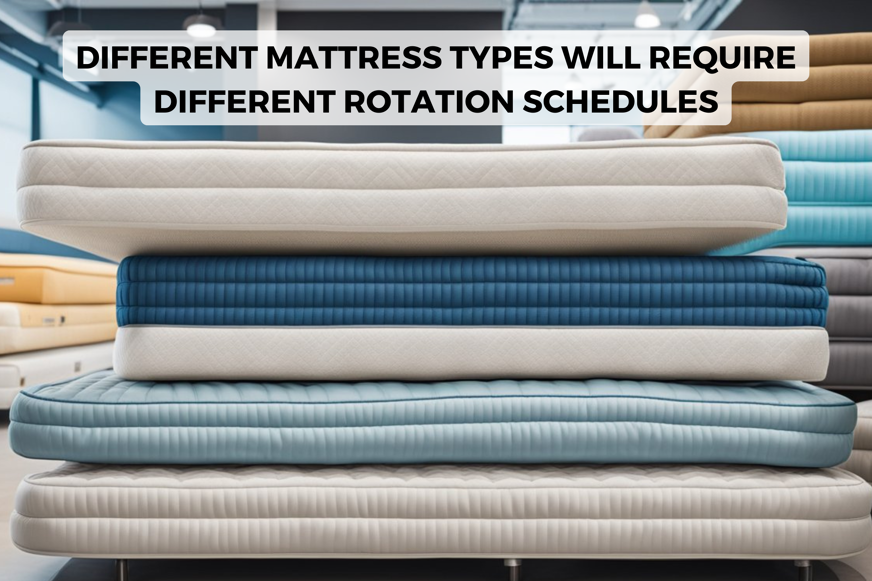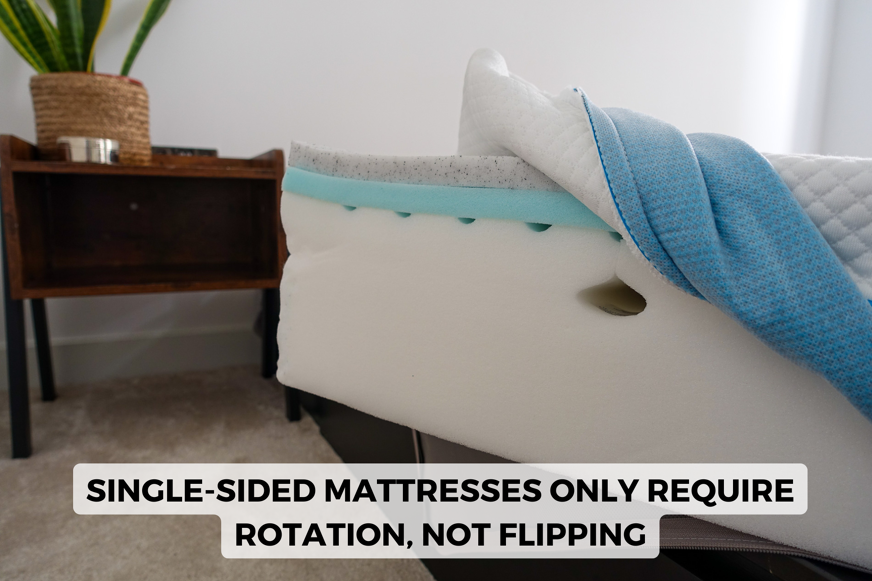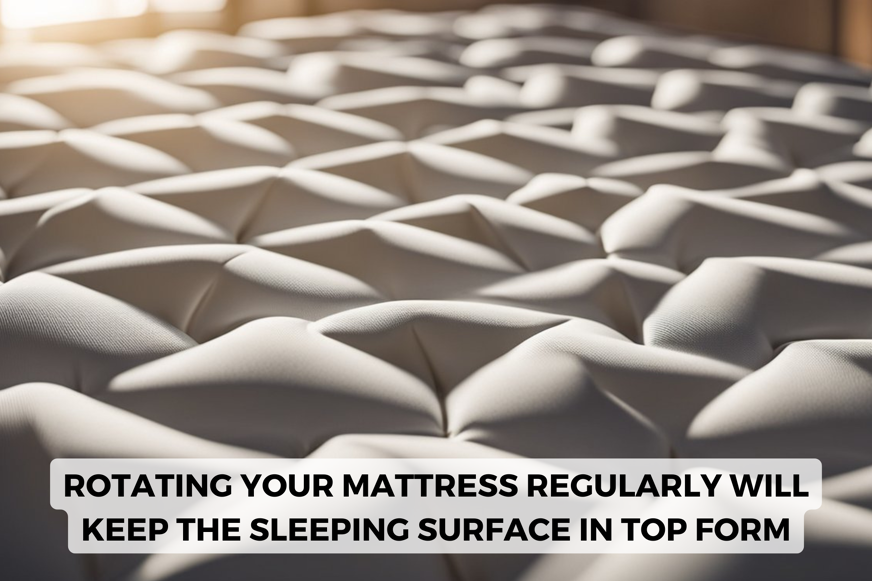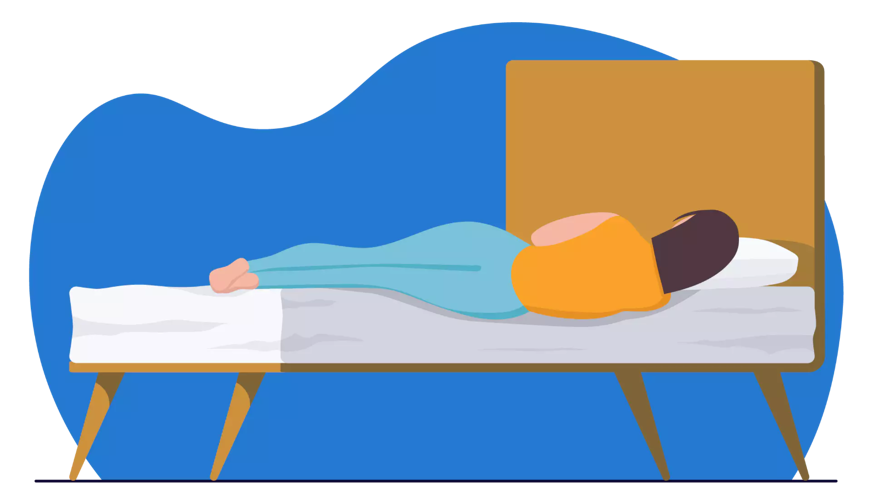Recommended mattress rotation frequency
Most mattress manufacturers recommend rotating your mattress at least every three to six months to ensure even wear.
For the initial few months after purchase, though, most manufacturers suggest more frequent rotation, perhaps every two weeks, to aid in the settling process.
Following this initial period, a quarterly rotation schedule is commonly advised.
Here are some key factors that influence how often you should rotate your mattress:
- Sleeping habits: Sleeping in the same spot consistently necessitates more frequent rotation to prevent localised wear.
- Mattress type: Memory foam and hybrid mattresses are more prone to body impressions, making regular rotation particularly important. Single-sided mattresses should only be rotated, not flipped.
- Weight distribution: Individuals with higher body weight may need to rotate their mattress more often to avoid sagging.
- Number of sleepers: Couples, especially those with significant weight differences, should consider more frequent rotation to maintain an even sleeping surface.
- Manufacturer instructions: Always prioritise the specific care guidelines provided with your mattress.
- Visible wear: Adjust your rotation frequency based on any signs of uneven wear or body impressions you observe.
Ultimately, paying attention to the manufacturer's recommendations and the specific wear patterns of your mattress will help you determine the ideal rotation schedule.
How mattress rotation frequency differs according to type
The ideal mattress rotation schedule often varies depending on the materials and construction of each mattress type.

Let's take a closer look at some key mattress materials.
How often should you rotate innerspring mattresses?
Innerspring mattresses tend to develop body impressions over time due to the spring system compressing under consistent pressure.
To mitigate this and maintain comfort, a regular rotation schedule is key to distribute weight across the coils.
Here are the key takeaways for rotating innerspring mattresses:
- Rotate every 2 - 3 months.
- For new mattresses, rotate monthly for the first six months to help the materials settle evenly around the springs.
- Follow specific advice from the manufacturer regarding their spring system.
Rotating helps prevent specific areas from wearing out prematurely and ensures more even support from the springs over time.
How often should you rotate memory foam mattresses?
Designed to contour to the body, memory foam can develop softer spots where pressure is consistently applied.
Rotation helps the foam recover its resilience more evenly across the surface.
Key things to remember when rotating memory foam mattresses:
- Rotate every 3 - 6 months to prevent excessive softening in specific areas.
- Flipping is generally not required due to the distinct comfort and support layers.
- Pay attention to any brand-specific rotation recommendations related to their unique foam densities.
Regular rotation helps maintain a more uniform feel and extends the responsive life of memory foam.
How often should you rotate hybrid mattresses?
Hybrid mattresses usually combine springs with foam or latex layers and need rotation to address potential wear in both the comfort layers and the underlying spring system.
Here's the recommended approach for rotating hybrid mattresses:
- Rotate every month for the first year to ensure even settling of both the springs and comfort layers.
- Then, rotate every 3 - 6 months afterward to continue even wear across the diverse materials.
- Check the manufacturer's care booklet for any specific instructions related to their unique layer combinations.
Rotating helps both the spring system and the comfort layers perform optimally and wear evenly.
How often should you rotate latex mattresses?
Even though they're known for their durability and resilience, latex mattresses can still develop slight indentations over time with consistent pressure.
Key points for rotating latex mattresses:
- Rotate every 3 - 6 months to ensure even compression and recovery of the latex.
- If your mattress is double-sided, alternate between rotating and flipping to maximise even wear on both sleeping surfaces.
- Always refer to the care label for specific instructions regarding the type of latex used.
Regular rotation helps the latex maintain its consistent firmness and support.
If you have a natural or organic mattress, like the Simba Source mattress, or a more custom-made one, like the Hästens mattresses, it's important to follow the manufacturer's rotation guidelines.
Is there a difference between rotating one-sided vs double-sided mattresses?
A one-sided mattress is designed to be slept on only one side.
- These mattresses should only be rotated from head to foot, never flipped.
- Rotating helps spread out the pressure and keeps the mattress comfortable for longer.
In contrast, a double-sided mattress can be flipped in addition to being rotated.

This means you can sleep on both sides, which can help the mattress wear more evenly over time.
Owners of double-sided mattresses should both rotate and flip them every three to six months for best results.
Why mattress rotation matters
Regularly rotating your mattress is a simple yet effective way to maintain its comfort and prolong its lifespan.
Here are the key benefits:
Extending mattress lifespan
Consistent rotation distributes normal wear and tear evenly across the entire mattress surface.
This prevents excessive pressure build-up in favoured sleeping spots, which particularly important for couples or those with consistent sleep positions.
By following manufacturer recommendations for rotation (typically every three to six months), you help the internal materials like springs and foam maintain their integrity and prevent premature breakdown.
This simple habit allows you to maximise the value and lifespan of your mattress.
Improving sleep quality
A supportive and even sleep surface is crucial for good sleep.
Over time, pressure points can develop, leading to discomfort, aches, and disturbed rest.
Rotating your mattress allows compressed areas to recover, maintaining a more uniform sleeping surface.

This even support promotes proper spinal alignment [1], potentially reducing morning pain and improving overall sleep quality for both solo sleepers and couples.
Preventing sagging and impressions
Consistent pressure on specific areas can lead to mattress sagging and body impressions.
Rotation helps to mitigate this by allowing different sections of the mattress to bear weight, reducing the likelihood of permanent indentations.
Sagging not only affects comfort but also the mattress's ability to provide adequate support and can disrupt sleep by making it difficult to change positions.
Regular rotation is a key part of mattress care that helps preserve its structure and extend its usable life.
Signs your mattress needs rotating
Visible sagging or uneven spots on the surface are key signs that a mattress needs rotating.
- If you often wake up with aches or notice that your bed feels lumpy, rotation might be overdue.
- Check for deep impressions where you usually sleep.
- If a mattress feels less supportive in places or you find it harder to get comfortable, it's time to change its position.
Rotating the mattress at the right time helps maintain even wear and avoid long-term damage.

That said, it's also important to know when your mattress is past its prime - look out for the signs of a bad mattress so you'll know when it's time to replace it.
On average, a mattress is designed to last about 5 - 15 years, but this can be influenced by factors such as the mattress type, frequency of use, and how well you care for it.
Common mistakes to avoid when rotating your mattress
Here's a quick look at some common mattress-rotation mistakes:
- Finding the right rotation frequency is key. Rotating too rarely leads to lasting body impressions and uneven comfort, while excessive rotation can be unnecessary and confusing.
- Another significant mistake is flipping a one-sided mattress, as this can damage the intended comfort layer. But if you have a double-sided mattress, remember to both flip and rotate it for the most even wear. The most important step is to always read your mattress manufacturer's care instructions.
These guidelines are specific to your mattress type and will help you avoid incorrect rotation practices, ultimately extending its lifespan and maintaining your sleep comfort.
Concluding thoughts on how often you should rotate your mattress
In conclusion, understanding when and how to rotate your mattress is a simple yet powerful way to protect your investment and enhance your sleep quality.
By following the guidelines specific to your mattress type and paying attention to signs of wear, you can ensure consistent comfort and prolong the life of your bed.
Make mattress rotation a regular part of your sleep routine for a more supportive and restful night's sleep.
Table of Contents
Recommended mattress rotation frequency
How mattress rotation frequency differs according to type
Is there a difference between rotating one-sided vs double-sided mattresses?
Signs your mattress needs rotating
Common mistakes to avoid when rotating your mattress
Concluding thoughts on how often you should rotate your mattress












Alternatively, message us directly via the Contact Us page.